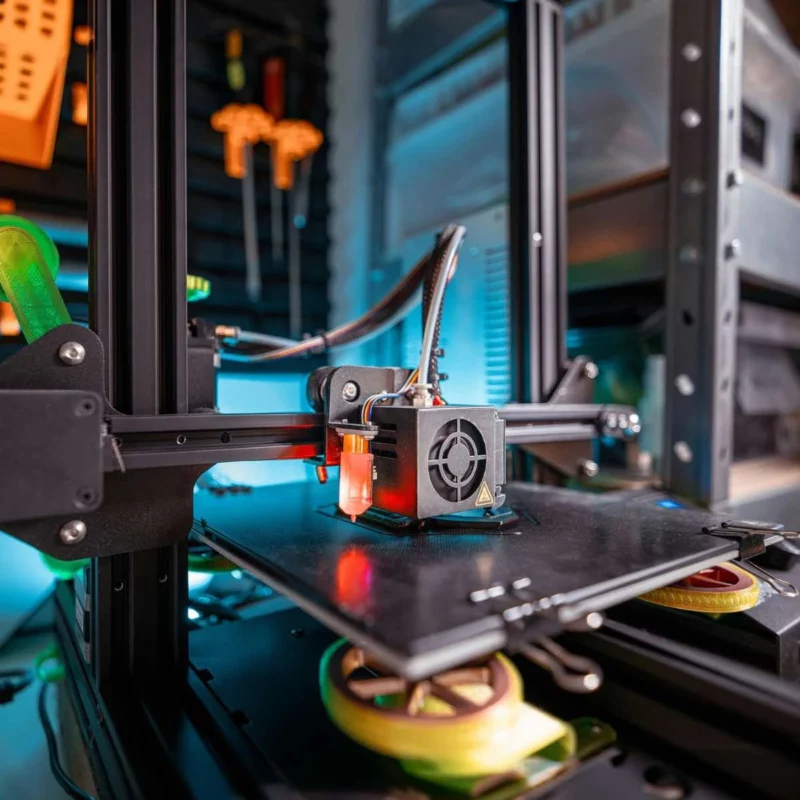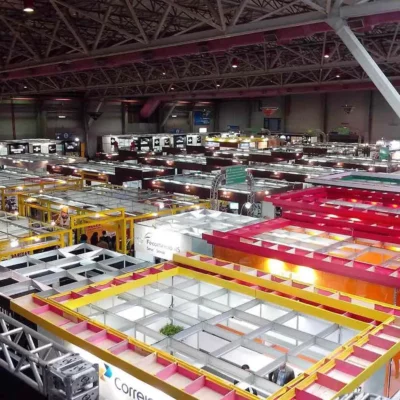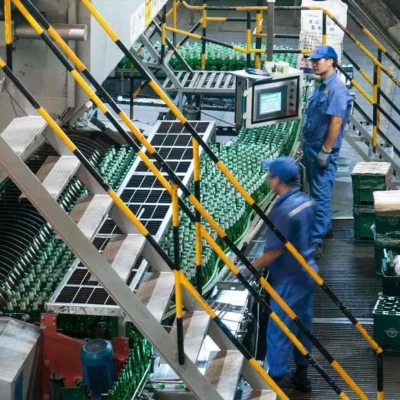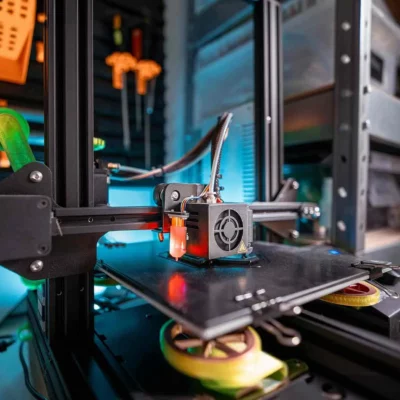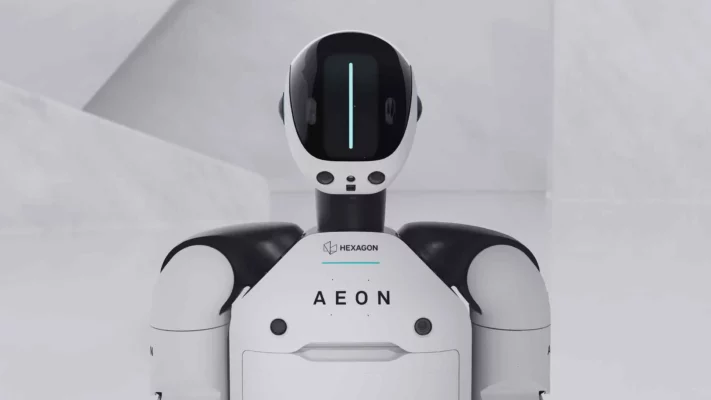3D scanners are changing the way you automate manufacturing. These devices capture detailed 3D models of objects, making them essential for precision tasks like quality control, bin picking, and reverse engineering. By using advanced scanning technologies, they help robots and automated systems “see” and interact with parts accurately. Whether you’re streamlining inspections, improving accuracy, or reducing production errors, 3D scanners play a crucial role in boosting efficiency.
In this article, you’ll learn what 3D scanners are, how they function, and why they’re changing industrial automation. Let’s take a look into how they can improve your production line.
What Are 3D Scanners?
A 3D scanner captures the shape and dimensions of an object in three dimensions. It does this by collecting data on its surface and geometry. You can think of it as a camera, but instead of taking pictures, it creates a digital 3D model of the object.
Purpose in Industrial Automation:
In manufacturing, 3D scanners help you create precise digital copies of parts and products. You can use them for quality control, reverse engineering, and automated inspection. With a scanner, your system can detect defects, improve accuracy, and speed up production. Companies using 3D scanning reduce errors and waste, improving efficiency.
How Does a 3D Scanner Work?
A 3D scanner captures the shape and dimensions of an object. It does this by collecting data from its surface and converting it into a digital model. There are different scanning methods, and the right one for you depends on your application.
Common Scanning Methods:
1. Structured Light Scanning:
Your scanner projects a pattern of light onto the scene and a camera records these images. As a result, the scene is converted into a 3D point cloud. Neither the scene nor the 3D sensor is in motion, which means that scanning is conducted in an extremely precise manner.
2. Laser Triangulation:
A laser beam shines on the object, and a sensor records how it reflects back. The scanner then calculates the object’s exact shape using triangulation. This method is great for capturing fine details.
3. Time-of-Flight (ToF):
The scanner sends a laser pulse toward the object and measures how long it takes to bounce back. Since light travels at a constant speed, the scanner determines the object’s distance. ToF scanners are useful for scanning large areas quickly.
What Happens Next?
Your scanner collects millions of data points, creating a 3D point cloud, a digital map of the object. Software then converts this into a 3D model you can use for inspection, automation, or quality control.
What’s the Difference Between a 3D Scanner & a 3D Vision System?
Choosing between a 3D scanner and a 3D vision system depends on what you need. Both capture 3D data, but they serve different purposes in industrial automation.
What is a 3D Scanner?
A 3D scanner creates a precise digital model of an object. It collects detailed shape and surface data, generating a point cloud. You can use this model for quality control, reverse engineering, or part verification. It’s ideal when you need exact measurements. [1]
What is a 3D Vision System?
A 3D vision system does more than capture data, it also analyzes and interprets it in real time. It can identify, sort, and guide robots to pick and place objects. Unlike scanners, vision systems help with dynamic automation, like robotic bin picking or defect detection. [2]
Key Differences:
- 3D Scanners → Capture and store precise object models for analysis.
- 3D Vision Systems → Capture, process, and react to data instantly.
If you need accurate 3D models, go with a scanner. If you need real-time decision-making, a vision system is the right choice.
Why Choose 3D Scanners Over 3D Vision Systems?
When automating your production, choosing between a 3D scanner and a 3D vision system is crucial. Both capture 3D data, but scanners provide higher accuracy, better adaptability, and more reliable performance in industrial settings. Here’s why a 3D scanner might be the better choice for you.
1. Higher Accuracy for Detailed Inspections:
If you need precise measurements, 3D scanners outperform vision systems. They capture fine details and provide exact dimensions of your parts. This makes them ideal for quality control and reverse engineering. Scape Technologies’ Industrial 3D Scanners use a patented view-based recognition method that combines 2D images with 3D point cloud data, giving you unmatched accuracy.
2. Better for Complex and Irregular Shapes:
Unlike many 3D vision systems, scanners work well on curved, textured, or flexible materials. Whether you’re scanning metal parts, molded plastic, or organic materials, a scanner ensures every detail is captured. This is critical for automotive and medical manufacturing, where precision is non-negotiable.
3. Reliable in Any Lighting Condition:
3D vision systems struggle in variable lighting such as shadows, glare, or poor illumination can lead to errors. 3D scanners don’t have this problem. They use structured light or laser technology, ensuring accurate scans regardless of ambient lighting.
4. Built to Withstand Harsh Environments:
Factories are dusty, wet, and unpredictable. Many 3D vision systems aren’t designed for tough conditions. Scape’s Industrial 3D Scanners are IP65-rated, meaning they are dustproof and water-resistant. However, for a truly rugged design, the Mini series is the better choice, it is built for robot mounting and designed to withstand shaking from robot movements. If you need durability in dynamic environments, the Mini series offers a major advantage.
If precision, adaptability, and durability matter in your production line, a 3D scanner is the smarter choice. It gives you detailed, accurate scans, works on any shape, performs in all lighting conditions, and withstands tough environments. If you want consistent, high-quality automation, a 3D scanner is worth the investment.
Applications in Industrial Automation:
3D scanning makes your manufacturing process faster, more accurate, and more automated. Whether you need to check product quality, redesign parts, or guide robots, the right 3D scanner can improve efficiency.
Quality Control:
3D scanners help you verify that your products match the original design. They scan parts and compare them to CAD models, detecting errors before they cause problems. This reduces waste and prevents defective products from reaching customers. More manufacturers are investing in this technology, with the global 3D scanning market expected to grow at 9.8% annually. [3]
Reverse Engineering:
When you need to replace or modify a part, 3D scanning makes it easier. Scanners create an exact digital model, helping you redesign and manufacture components faster. 3D scanners capture high-resolution scans, ensuring precise modeling. This is especially useful when working with outdated parts that don’t have original blueprints.
Robotics Integration:
3D scanning helps robots see and interact with objects accurately. This is key for tasks like bin picking, sorting, and assembly. Scape Bin-Picker uses 3D vision to detect and pick randomly placed parts. Scape CoCreator® improves robot guidance, ensuring objects are correctly positioned for precision tasks. The CoCreator® is a no-code robot programming software that simplifies the deployment of automation solutions, making it easy for users to program robots without coding expertise. When you integrate 3D scanning with robotics, you reduce errors and increase production speed.
When you integrate 3D scanning with robotics, you reduce errors and increase production speed.
The video showcases Scape Technologies’ innovative industrial bin-picking solutions designed to automate processes with precision and efficiency.
By using 3D scanning in these areas, you improve quality, speed up production, and cut costs, all while making your automation smarter.
To learn more about 3D scanner applications, check out this article:
Benefits of 3D Scanning in Manufacturing:
Precision:
3D scanners capture even the smallest details of your products. You get highly accurate digital models that match your design exactly. This helps you catch defects early and maintain consistent quality. In aerospace manufacturing, for example, precision is critical to ensure parts fit perfectly and meet safety standards.
Efficiency:
3D scanning collects data much faster than traditional methods. Instead of spending hours measuring parts manually, you can scan and process them in minutes. This reduces labor costs and shortens production time. Compared to older surveying techniques, 3D scanning speeds up projects significantly.
Cost Savings:
With 3D scanning, you don’t need to create as many physical prototypes. You can test and refine digital models before manufacturing, saving materials and money. This approach has helped industrial manufacturers cut costs and speed up product development. Many companies see a quick return on investment after adding 3D scanners to their workflow.
Challenges & Considerations in 3D Scanning:
While 3D scanning improves accuracy and efficiency, certain challenges can affect your results. Understanding these issues will help you get the best performance from your scanner.
Surface Reflectivity:
Highly reflective surfaces, like polished metal, can scatter laser beams and distort your scan. Transparent materials, like glass, can cause errors by letting the laser pass through instead of bouncing back. To fix this, you can apply a temporary matte spray to reduce reflections and improve accuracy.
Environmental Factors:
Changes in lighting, temperature, and humidity can impact your scan quality. Bright ambient light may interfere with laser-based scanners, and extreme temperatures can affect sensor accuracy. To get consistent results, scan in a controlled environment with stable lighting and temperature.
Data Management:
3D scanners create massive datasets, which require powerful computers and storage solutions. Processing high-resolution scans can slow down your workflow if your system isn’t optimized. Investing in high-performance hardware and efficient 3D processing software helps you manage these large files without delays.
By addressing these challenges, you can get more reliable scans and improve the efficiency of your automation process.
Common Myths About 3D Scanning:
Many engineers hesitate to invest in 3D scanners due to outdated misconceptions. Let’s address some of these myths:
Myth 1: 3D Scanning Is Too Expensive
Many believe that 3D scanning technology is prohibitively costly, especially for small manufacturers. However, advancements have made 3D scanners more affordable.For instance, Scape Technologies offers models like the Ultra-XL and Mini Pro-700 at €8,000 and €5,000 respectively, providing strong accuracy and reliable performance at competitive prices.
To learn more about 3D scanner prices, check out this article:
Myth 2: Scanners Struggle with Reflective or Dark Surfaces
It’s a common belief that 3D scanners cannot accurately capture data from shiny or dark surfaces. Modern scanners utilize advanced algorithms and technologies to handle such challenges effectively.
Myth 3: 3D Scanning Is Complicated and Requires Experts
Some think that operating 3D scanners is complex and demands specialized expertise. Contemporary scanners are designed with user-friendly interfaces and plug-and-play capabilities, making them accessible even to those without extensive technical backgrounds.
By dispelling these myths, you can make informed decisions about incorporating 3D scanning technology into your manufacturing processes.
How to Choose the Right 3D Scanner for Your Needs:
Not all 3D scanners are the same. To find the best one for your production, focus on these key factors:
1. Scanning Speed: Do You Need Fast or Detailed Scans?
If you need real-time scanning for automation, choose a high-speed scanner. If precision is more important than speed, go for a high-accuracy model that captures fine details.
2. Resolution: What Level of Detail Do You Need?
For tiny, intricate parts like microelectronics, you need high resolution. If you’re scanning large parts like car components, lower resolution will still do the job while keeping processing times short.
3. Material Compatibility: Can It Handle Your Parts?
Not all scanners work well with shiny, dark, or transparent surfaces. Make sure your scanner has advanced algorithms to handle tricky materials without errors.
4. Robotics Integration: Does It Work with Your Automation?
If you’re using robotic arms or bin-picking systems, pick a scanner that seamlessly integrates with your setup. This keeps automation smooth and error-free.
Comparison of 3D Scanner Types:
| Scanner Type | Best For | Considerations |
| Structured Light | Fast, precise scans of small to medium parts | Can struggle with bright or reflective surfaces |
| Laser Triangulation | High-detail scans of small objects | Slower than structured light |
| Photogrammetry | Large objects or outdoor environments | Lower accuracy, needs good lighting |
Choosing the right 3D scanner ensures better accuracy, faster workflows, and smoother automation. Pick one that fits your needs and your factory will run more efficiently.
Conclusion:
3D scanners are changing the way you automate manufacturing. They help you detect defects, speed up production, and improve robotic accuracy. Whether you’re using them for quality control, reverse engineering, or bin picking, they give you precise, reliable results. Modern scanners handle shiny, dark, and complex surfaces with ease. They also integrate seamlessly with robots, making automation smoother. Plus, affordable options mean even small manufacturers can benefit. If you want to reduce errors, cut costs, and future-proof your production, investing in a 3D scanner is the smart move.
References:
- Hermary. (n.d.). When to Use 2D Over 3D Scanners. Retrieved on February 3, 2025, from https://hermary.com/learning/when-to-use-2d-over-3d-scanners/
- Industrial Vision Systems. (n.d.). 3D Vision Systems Applications. Retrieved on February 3, 2025, from https://www.industrialvision.co.uk/applications/3d-vision-systems
- Grand View Research. (n.d.). 3D Scanning Market Size, Share & Trends Analysis Report. Retrieved on February 3, 2025, from https://www.grandviewresearch.com/industry-analysis/3d-scanning-industry
